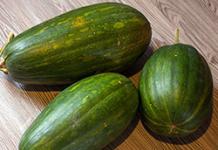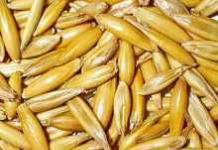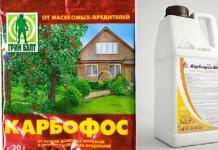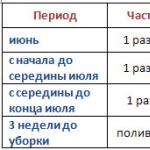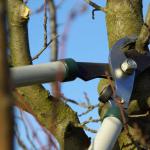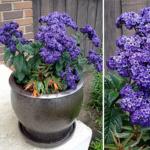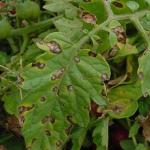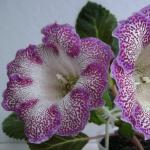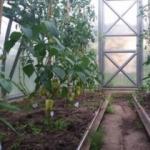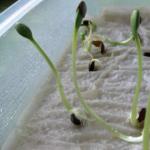After planting in open ground, onions requires careful care. Watering and fertilizing play a key role here, because water and fertilizers are the main sources of nutrients necessary for growth. Therefore, if the onion does not grow well, the first thing to do is feed.
Basic rules of watering:
- Water the onions It is recommended to use a watering can with a strainer, carefully so as not to damage the feather.
- Approximately 3 weeks before harvesting, stop watering the onions - this helps to avoid cracking of the bulbs and increase shelf life.
- Water the onions generously, moistening the soil to a depth of 15-20 cm.
- The optimal time for watering is evening.
- When a crust forms after watering, the soil is loosened to open oxygen access to the root system.
- However, onions also do not tolerate excess moisture well, so experts recommend sprinkler watering systems for them. Such a system facilitates accurate dosing of water.
- It is useful to add fertilizers to water for irrigation, thus combining watering with fertilizing.
How often and how much to water onions?
The frequency of watering onions depends on weather conditions and the stage of plant development. So, in June, when the weather is mostly hot and dry, water consumption is approximately 10-liter bucket per 1 square meter. In July, the frequency of watering remains the same - once every 8-10 days, but water consumption decreases. Approximately a month before harvesting, watering is stopped - this reduces the risk of cracking of the bulbs and they are stored longer. Based on the recommendations given in the dacha literature that how often and how much to water onions, we have compiled a watering calendar table.
Watering calendar:

How to feed onions to grow?
If onions grow poorly, in addition to watering, they carry out feeding. To do this, use a solution of mullein with water in a ratio of 1 to 12. Add 30 g of ammonium nitrate to the bucket of the solution.
Feed onions mineral fertilizers can be used from the moment of emergence of seedlings:
- In the first week, add ammonium nitrate according to the instructions on the package.
- In the next 3 weeks, add ammonium nitrate, any water-soluble complex fertilizer and calcium nitrate.
The composition of mineral supplements is adjusted taking into account the growing season of the variety and the condition of the plants:
- In the first half of the growing season, nitrogen fertilizing is necessary.
- In the 2nd half of the growing season - phosphorus-potassium (excess nitrogen at this time is dangerous with the likelihood of developing neck rot on the bulbs).
Three-time feeding scheme with mineral fertilizers:

Feeding onions with folk remedies
In addition to those listed above, there are many other feeding options. For the most part, these are folk remedies that gardeners share on country forums:
- Feeding with ash and mullein infusion. Wood ash is scattered on the surface of the earth around the plants or an ash solution is prepared for irrigation in the dosage: 1 teaspoon of wood ash per 1 liter of water. It is recommended to alternate feeding onions with ash with mullein infusion (diluted in water 1:12). Important: you need to feed at sufficient intervals. .
- Watering the onions with yeast. Very often onions are fed with yeast. The main ingredient here is dry or fresh yeast and bread crumb. Recipe: 500 gr. dissolve the bread crumb in a 10-liter bucket of warm water, add 500 gr. fresh green grass and 500 gr. fresh yeast. The solution should be infused for 2 days. Fertilizing with yeast infusion is carried out instead of traditional watering.
- Watering onions with ammonia will help, if the feathers of the onion have turned yellow. Experienced gardeners are sure that this is a sign of nitrogen deficiency. For feeding, prepare a solution: 3 tbsp. l. ammonia per 10 liters of water. The resulting solution is poured under the roots of the onion in the evening.
06.09.2015
54 277
How to grow large onions on your own plot?

We can talk endlessly about the benefits of onions, but the question of how to grow large onions is always of interest to many summer residents and gardeners. The agricultural technology of growing onions is not complicated, but it has some tricks and subtleties...
To ensure that the onions are large, we prepare the bed correctly
Onions grow in any soil, but it would be best to grow them on fertile and loose soil. Clay soils are also not suitable for growing onions; they are too heavy for them. In this case, the area for planting onions must be sunny. It will be good if you plant onions in the place where you previously grew: potatoes, cucumbers, cabbage, tomatoes or zucchini. 
The land allocated for beds must first be dug up and fertilizer added, as well as all weeds removed. It is advisable to prepare the soil for planting onions in the fall, spread rotted manure, compost or humus. Fertilizers usually include saltpeter, potassium chloride, and superphosphate.
As a rule, onions grow well in soils with neutral acidity. Well, if the soil is acidic, then it can be diluted, for example, with ash or lime.

To ensure that the soil for the onions warms up enough, dig up the bed again in the spring and only then start planting. The length and width of the beds can be whatever is more convenient for you, the most important thing at this point is that it is advisable to make the distance between the rows at least 20 centimeters. The seedlings are deepened by 2-3 centimeters maximum. Sowing too deep will inhibit the growth of the bulb, which can cause the onion to go into the shoot.
How to increase onion yields by fertilizing?
In order for the onion to be large, it must be fed. Even a crop like onion also requires feeding. You can fertilize with both mineral and organic fertilizers. During the entire growth period, it is recommended to feed onions no more than three times.
The first fertilizers can already be applied 10-14 days after the onions have been planted. It is advisable to apply nitrogen fertilizers so that the onions increase their green mass. The second stage of fertilization is carried out about a week or two after the first fertilizing. In this phase, nitrogen fertilizers are reduced and potassium and phosphorus are increased. The third time occurs at the stage of formation of the bulb itself. This type of fertilization of onions is usually carried out on depleted soils, and if your land is fertile, then you can refuse this fertilizing.
 Now there are a large variety of mineral fertilizers on the market, so in order to increase the yield of onions, fertilizers such as Agricola-2 for onions, Vegeta, and Effecton-O are usually used. The solution should be diluted according to the instructions. Usually use a maximum of two tablespoons per 10 liters of water. It is advisable to fertilize in the evening.
Now there are a large variety of mineral fertilizers on the market, so in order to increase the yield of onions, fertilizers such as Agricola-2 for onions, Vegeta, and Effecton-O are usually used. The solution should be diluted according to the instructions. Usually use a maximum of two tablespoons per 10 liters of water. It is advisable to fertilize in the evening.
As first feeding You can also use the following solutions:
- you need 1 tablespoon of ammonium nitrate, 60 grams of superphosphate and an incomplete tablespoon of potassium chloride, and shake it all in 10 liters of water;
- dissolve 60 grams of ammonia in a bucket of water. Such fertilizing will not only increase the yield of onions, but will also rid the onions of some pests, for example, the onion fly.
Example second feeding: take 10 liters of water, add 30 grams of ammonium nitrate and potassium chloride, add 50-60 grams of superphosphate. You can also dilute a tablespoon of salt and ammonium nitrate in a bucket of water, adding manganese on the tip of a knife.
For third feeding dilute 50 grams of superphosphate in a 12-liter bucket of water, you can also add potassium salt alone, about 30 grams.
Often, therefore, it is necessary to find out why this happened and, of course, eliminate it, since the consequences may not be comforting and the onion yield will be low because of this.
When fertilizing onions, try not to get the solution on the feathers. And it is very important to monitor the onions in the garden, and not what everyone around is recommending. If your onions are green and healthy, then the soil on the site is very fertile, so it is better to refrain from fertilizing. If there is a lack of potassium, the onion feathers will turn yellow, then fertilize it. If the tips of the feathers of the onion dry out, it means that it lacks phosphorus. And pale and weak feathers indicate a lack of nitrogen.
Therefore, if you want the onions to be large and the onion yield to be large, it is extremely important to maintain a balanced fertilizer and know what to feed the onions in each specific case.
Onions are one of the first plants that humans began to grow. It is about four thousand years old from the moment of cultivation and the beginning of cultivation.
It is impossible to imagine any kitchen in the world without this vegetable, because most dishes without its use seem bland and tasteless. There are quite a few varieties of onions, and each has its fans.
Each gardener has his own secrets for good ripening of onions in the garden, but the most important thing is to adhere to the correct agricultural technology in order to obtain a large harvest, whether planted in a ridge or from seeds.
Not the most fastidious plant is considered cold-resistant, grows well at temperatures of twelve to sixteen degrees Celsius, seeds germinate even at five degrees in the cold season. Spicy varieties tolerate frost better; sweet varieties can die in open ground at a few degrees of frost.
Onion responds well to watering in the first stages of growth, in the future it needs dry soil in order to ripen better. It needs more sunlight. Despite its small mass, onions require special attention to the soil composition. The soil in the garden bed should be quite loose and nutritious.
Onions should not be planted in places where groundwater is close to the surface of the earth.
Weeding of the beds must be carried out regularly, since the crop does not tolerate proximity to weeds.
The right decision would be to organize onion beds and plant vegetables in the places where they grew before. cucumbers, cabbage, tomatoes or potatoes. These are the vegetables for which organic matter is added to the soil.
Increased acidity of the soil is harmful to the plant, as it absorbs nutritional components worse and can be affected by downy mildew.
Before planting onions does not tolerate liming of soil composition, it is recommended to use wood ash.
How to grow large and good bulbs in open ground
One of five options is most often used - sets, seeds, seedlings, vegetative method, Chinese.
The Chinese way - how to plant using technology in ridges

This option might help increase productivity. The main feature is planting onions on ridges, and not in the beds themselves. The heads grown in this way are distinguished by their flattened shape and large size. The tops of the vegetable are well illuminated by sunlight and warm up, from which the onion receives good protection from the effects of rot.
It should be added that it is better to loosen and water such beds, and remove weeds from them.
You can sow at air temperatures equal to 5 degrees. The planting material must be sorted out; smaller bulbs can be planted as the soil warms up. Larger ones should be held back until May. This measure will give you the opportunity to harvest at the same time.
After sorting, the seedlings are warmed up a couple of weeks before planting. To do this, it is placed in a box and placed near the battery.
Be sure to be careful with each bulb the tail is trimmed, excess scales are removed. If you damage the growth neck, you can put the material aside. It is no longer suitable for landing.
One day before planting, the material is soaked in warm water to give impetus to the formation of the root system.

The soil for planting must be prepared in the fall. A spoonful of superphosphate, a teaspoon of nitroammophosphate, and two teaspoons of dolomite flour are added to each square of the plot. In the spring, the bed needs to be dug up again; you can add a little manure, but not too fresh.
Ridges are arranged, the height of which should be about fifteen centimeters, the interval between them is up to thirty. The sets are planted every ten centimeters to a three-centimeter depth. The seeds should not be trampled; it would be better to lightly sprinkle them with earth.
In the first month of growth, if the weather is dry, the onions should be watered twice. But this is only if it rained between waterings.
You can feed three times. In mid-May, mullein is added. In June it is the turn of potassium salt, urea and phosphate fertilizers. It is necessary to fertilize the third time at the moment when the bulbs begin to form.
Another feature of the Chinese method is that Weeding the beds is necessary as the weeds grow, which happens quite rarely.
Copper sulfate is used as a protective measure against powdery mildew.
Method of planting and sowing seeds in the soil
In mid-spring, the seed material is calibrated, more large specimens. After dry sowing, the first shoots will appear in three weeks. To speed up the process, you can soak the seeds in potassium permanganate, and after a day, scatter them on fabric and leave them alone so that they hatch. But at the same time, it is necessary to ensure that the planting material remains sufficiently moist.
Furrows are made at a distance twenty centimeters. One gram of seeds is enough for two meters of sowing, planting depth is up to three centimeters. For convenience, you can mix the seeds with sand and sprinkle the furrows with dry soil after planting.

When to plant in the garden
Landing time depends on weather conditions. If the weather is warm in the spring, then sowing can be done in the last days of April. Otherwise, you will have to wait until the earth warms up.
Pre-grown seedlings are transferred to the ground no earlier than mid-May.
Sevok lands in the first decade of May. Residents of the northwestern regions can be guided by the flowering of bird cherry when planting onions.
For winter sowing, the beds are prepared in the fall. Landing is underway in the second half of November, until frost.
Secrets of proper agricultural technology
Do not allow crust to form on the surface of the soil or weeds to appear. For this purpose, the beds need to be loosened more often to a depth of up to five centimeters. It is better to remove weeds in the initial growth phase, when the seedlings are still reddish.
 After the turnip begins to form, it needs to be opened a third
After the turnip begins to form, it needs to be opened a third It must be remembered that onions love to show off. When a turnip begins to form, it must be open a third, releasing the hangers. This technique helps the bulb to form well and fully ripen.
Harvesting turnips and feathers and storing them
As soon as new feathers have stopped appearing and the onion has acquired a characteristic shade, it can be removed. As a rule, this occurs on mid-August – early September. If you skip harvesting time, the vegetable will begin to grow again and will be of little use for storage.
The collected bulbs are washed, cleaned of husks and dry feathers, roots are trimmed. To dry, lay it out in one layer in a well-ventilated room. After a few weeks, new golden scales appear on the bulbs. This means that the vegetable is ready for long-term storage.

As a rule, gardeners prefer to grow onion sets, purchasing them in special stores. It can be planted in winter by first preparing the bed.
The best option for winter planting is considered to be a small seedling with a diameter of up to 1 centimeter; it usually does not shoot shoots.
If you are not sure about the quality of the seedlings, then for 15 days before planting it is better to warm them up at a temperature of +25-30°C. This should reduce the likelihood of arrowheads appearing.
You should not plant bulbs that are too large in the ground, as they often produce a small harvest.
Poor growth of onions due to delays in planting
If you plant bulbs in early spring when the soil has not yet warmed up, they may not sprout, and if they do hatch, you are guaranteed to see arrows.
For planting, make beds up to two centimeters deep in the ground and insert the bulbs into them at a distance of about 20 centimeters from each other. The beds are watered with warm water and covered with plastic wrap. After the seedlings hatch, the film is removed.
Poor growth of onions due to improper watering
This error is one of the main ones. It is necessary to water the beds daily with warm water once a day, but you should also take into account what the weather is like outside. It is not recommended to water during the day in the heat; it is better to do it in the morning or evening. And you should not water the beds immediately after the rains: if the soil is waterlogged, the onions will not be able to ripen. 
Poor growth of onions due to dense soil
Onions like loose soil, where the bulb will form, pushing the soil around with its dimensions.
Poor growth of onions due to high acidity of the soil
Soil acidity should not exceed pH 6.4-7.9. If the soil is acidic, it is best to feed with wood ash.
Poor growth of onions due to a lack or excess of nitrogen in the soil
Onions are very picky about the amount of nitrogen in the soil. Its deficiency leads to yellowing and drying of the bulbous feathers, and then to the death of the beds. An excess of this element leads to rotting of the bulbs directly in the soil, so it is recommended to find out how much nitrogen the planted variety needs. You can apply both organic and mineral fertilizers. Of the minerals, it is recommended to use urea, or, as it is also called, urea. Organic ones should be used with caution, as they can cause fungal diseases.
Poor growth of onions due to low temperatures
Onions are fairly cold-resistant plants. But the plant must be protected from frost, since the minimum temperature for seed germination is -5. The leaves of adult plants can withstand down to -2; at lower temperatures the plant dies.
Poor growth of onions due to disease damage
Fusarium. One of the onion diseases caused by a fungus. The reason may be that the plant is damaged by one of the onion pests while growing in the garden. The fungus develops at the bottom, causing the roots to die. The bulb stops developing, the leaves turn yellow, and the plant dies.
If the infection occurred at the end of the onion growing season, then when harvesting it is quite possible not to notice the damage to the bulb. And already in storage, the disease will develop further, and the vegetable will rot.
Preventive measures that will prevent the occurrence of the disease:
§ plant protection from onion fly
§ watering with infusion of ash
§ compliance with crop rotation
§ treatment of onion seeds before planting
§ loosening row spacing.
Gray rot. This disease of onions in the garden, like gray rot, begins to develop even when harvesting last year’s harvest. Spores of the Botrytis fungus most often penetrate the vegetable through the neck of the onion that has not yet closed during drying. The first signs of the disease become visible already during crop storage:
· the fruits begin to deteriorate at the base of the neck: gray rot becomes visible on the surface;
· when pressing on the bulb near the neck, the tissues are crushed;
· in the section, the affected layers of the onion are visible: they are soft, cloudy, often gray, reminiscent of boiled onions.
During storage, healthy fruits can become infected with spores through damage to the surface caused during harvesting or by insects. Favorable conditions for the development of the fungus: high humidity in the storage and high temperature.
During the growing period, the beds are treated with Kvardis, Bravo and Switch, strictly according to the instructions. The fight against traditional methods consists in artificially accelerating the ripening of fruits. Limiting nitrogen fertilizing and increasing potassium-phosphorus fertilizing contributes to the rapid development and premature drying of leaves, due to which the neck closes faster.
Bacterial rot of onion seeds. The causative agent of onion disease is most often the bacterium Erwinia carotovora Bergey, which can cause vascular and parenchymal lesions. The source of infection is contaminated soil and affected post-harvest onion residues. Bacteria are spread by splashing raindrops, irrigation water and insect pests. Sometimes other bacteria also cause bulb rot: Pseudomonas aeruginosa, Pseudomonas gladioli and others.
Microorganisms cause soft rot diseases of various organs. In affected bulbs, a large light or slightly pink spot forms around the stem end. The tissue softens and becomes covered with mucus. In such heads, the first outer layer of scales is healthy, and the next ones become yellow-brown. When severely damaged, the tissues soften, emitting an unpleasant odor.
Downy mildew or downy mildew. Onions become sick already in early June, but the disease can occur later. The disease manifests itself in the appearance of a slight light gray coating on the leaves, and then on the arrows. After 2-3 days, the affected areas of the onion begin to turn yellow, then, due to damage by black mold, they turn black and become unfit for food. Arrow damage significantly reduces the yield of seeds and aerial bulbs. Onions are more affected than other types of onions: in 5–7 days, powdery mildew can cover the entire area. Chives are less susceptible to this disease.
Measures to protect onions from peronosporosis and other diseases are:
- transferring the onion to another place from the previous site;
- using only healthy seeds and plants for propagation.
- providing onion crops with nutrients, especially potassium, and providing sufficient moisture.
- spraying with 1% Bordeaux mixture twice during the summer: at the end of June-beginning of July, again after 10–15 days.
- weed control and removal of onion plant residues after harvesting.
Latest articles about gardening
Poor growth of onions due to pest damage
Among the insects that cause great damage to the onion crop, the onion fly, onion moth and stem nematode are especially distinguished.
Onion fly. A dangerous, widespread pest of onion plantings. It causes more damage on loamy and sandy soils, and to a lesser extent on peat bogs. Onions are more seriously damaged in private gardens when the crop is cultivated for a long time in one place. Damages various types of onions, less so garlic. It is more harmful to onions sown with seeds.
The larvae, penetrating into plant bulbs through the bases of leaves or the bottom, make passages in them. Larvae hatched from eggs laid on a feather can feed inside it. The leaves of damaged plants first wither, become yellowish-gray, and then dry out, the bulbs rot.
Fighting the onion fly. Fly beetle preparations are used at a rate of 50 g/10 m2 by applying to the soil surface when planting bulbs; Medvetox at a rate of 30 g/10 m2 by applying to the soil surface when planting bulbs with simultaneous loosening; Ant at a rate of 30 g/10 m2 by applying to the beds immediately after sowing, Zemlin at a rate of 30 g/10 m2 by applying to the soil surface when planting bulbs with simultaneous loosening. Tobacco dust or Tabazol is also used by dusting during the growing season at a rate of 3 g per 1 sq.m.
Stem nematode is a pest that lives in the ground. To avoid infection with it, planting material should be treated: heated for 12 hours at a temperature of about 50°C or soaked in salt water for 48 hours. It is also necessary to observe crop rotation, regularly lime the soil of the site and remove the remains of vegetable crops from the beds.
Onion moth. The onion moth itself does not damage the plantings, but its larvae are malicious pests of onions. They feed on plant tissues, penetrating inside its leaves. As a result, the above-ground part of the plantings turns yellow and eventually dies completely. After this, the bulb also stops growing, having received less nutrients and plastic substances from the feather. In order not to decide how to treat onions against pests, you should make sure that moths cannot lay eggs on the surface of the plants. To do this, many experienced gardeners, during the summer of insects, build a shelter over the beds from the thinnest non-woven material or equip the beds with various repellers.
Astrakhan tomatoes ripen remarkably well lying on the ground, but this experience should not be repeated in the Moscow region. Our tomatoes need support, support, garter. My neighbors use all sorts of stakes, tie-downs, loops, ready-made plant supports and mesh fencing. Each method of fixing a plant in a vertical position has its own advantages and “side effects”. I'll tell you how I place tomato bushes on trellises and what comes out of it.
Flies are a sign of unsanitary conditions and carriers of infectious diseases that are dangerous to both people and animals. People are constantly looking for ways to get rid of unpleasant insects. In this article we will talk about the Zlobny TED brand, which specializes in fly repellents and knows a lot about them. The manufacturer has developed a specialized line of products to get rid of flying insects anywhere quickly, safely and at no extra cost.
The summer months are the time for hydrangeas to bloom. This beautiful deciduous shrub produces luxuriously fragrant flowers from June to September. Florists readily use large inflorescences for wedding decorations and bouquets. To admire the beauty of a flowering hydrangea bush in your garden, you should take care of the proper conditions for it. Unfortunately, some hydrangeas do not bloom year after year, despite the care and efforts of gardeners. We will explain why this happens in the article.
Every summer resident knows that plants need nitrogen, phosphorus and potassium for full development. These are three main macronutrients, the deficiency of which significantly affects the appearance and yield of plants, and in advanced cases can lead to their death. But not everyone understands the importance of other macro- and microelements for plant health. And they are important not only in themselves, but also for the effective absorption of nitrogen, phosphorus and potassium.
Garden strawberries, or strawberries, as we used to call them, are one of the early aromatic berries that summer generously gifts us with. How happy we are about this harvest! In order for the “berry boom” to repeat every year, we need to take care of the berry bushes in the summer (after the end of fruiting). The laying of flower buds, from which ovaries will form in the spring and berries in the summer, begins approximately 30 days after the end of fruiting.
Spicy pickled watermelon is a savory appetizer for fatty meat. Watermelons and watermelon rinds have been pickled since time immemorial, but this process is labor-intensive and time-consuming. According to my recipe, you can simply prepare pickled watermelon in 10 minutes, and by the evening the spicy appetizer will be ready. Watermelon marinated with spices and chili can be stored in the refrigerator for several days. Be sure to keep the jar in the refrigerator, not only for the sake of safety - when chilled, this snack is simply licking your fingers!
Among the variety of species and hybrids of philodendrons, there are many plants, both gigantic and compact. But not a single species competes in unpretentiousness with the main modest one - the blushing philodendron. True, his modesty does not concern the appearance of the plant. Blushing stems and cuttings, huge leaves, long shoots, forming, although very large, but also a strikingly elegant silhouette, look very elegant. Philodendron blushing requires only one thing - at least minimal care.
Thick chickpea soup with vegetables and egg is a simple recipe for a hearty first course, inspired by oriental cuisine. Similar thick soups are prepared in India, Morocco, and Southeast Asian countries. The tone is set by spices and seasonings - garlic, chili, ginger and a bouquet of spicy spices, which can be assembled to your taste. It is better to fry vegetables and spices in clarified butter (ghee) or mix olive and butter in a pan; this, of course, is not the same, but it tastes similar.
Plum - well, who isn’t familiar with it?! She is loved by many gardeners. And all because it has an impressive list of varieties, surprises with excellent yields, pleases with its diversity in terms of ripening and a huge selection of color, shape and taste of fruits. Yes, in some places it feels better, in others it feels worse, but almost no summer resident gives up the pleasure of growing it on his plot. Today it can be found not only in the south, in the middle zone, but also in the Urals and Siberia.
Many ornamental and fruit crops, except drought-resistant ones, suffer from the scorching sun, and conifers in the winter-spring period suffer from sunlight, enhanced by reflection from the snow. In this article we will tell you about a unique product for protecting plants from sunburn and drought - Sunshet Agrosuccess. The problem is relevant for most regions of Russia. In February and early March, the sun's rays become more active, and the plants are not yet ready for new conditions.
“Every vegetable has its own time,” and every plant has its own optimal time for planting. Anyone who has dealt with planting is well aware that the hot season for planting is spring and autumn. This is due to several factors: in the spring the plants have not yet begun to grow rapidly, there is no sweltering heat and precipitation often falls. However, no matter how hard we try, circumstances often develop such that planting has to be carried out in the midst of summer.
Chili con carne translated from Spanish means chili with meat. This is a Texas and Mexican dish whose main ingredients are chili peppers and shredded beef. In addition to the main products there are onions, carrots, tomatoes, and beans. This red lentil chili recipe is delicious! The dish is fiery, scalding, very filling and amazingly tasty! You can make a big pot, put it in containers and freeze - you'll have a delicious dinner for a whole week.
Cucumber is one of the most favorite garden crops of our summer residents. However, not all and not always gardeners manage to get a really good harvest. And although growing cucumbers requires regular attention and care, there is a little secret that will significantly increase their yield. We are talking about pinching cucumbers. Why, how and when to pinch cucumbers, we will tell you in the article. An important point in the agricultural technology of cucumbers is their formation, or type of growth.
Now every gardener has the opportunity to grow absolutely environmentally friendly, healthy fruits and vegetables in their own garden. Atlant microbiological fertilizer will help with this. It contains helper bacteria that settle in the root system area and begin to work for the benefit of the plant, allowing it to actively grow, remain healthy and produce high yields. Typically, many microorganisms coexist around the root system of plants.
Summer is associated with beautiful flowers. Both in the garden and in the rooms you want to admire the luxurious inflorescences and touching flowers. And for this it is not at all necessary to use cut bouquets. The assortment of the best indoor plants includes many beautifully flowering species. In the summer, when they receive the brightest lighting and optimal daylight hours, they can outshine any bouquet. Short-lived or just annual crops also look like living bouquets.
